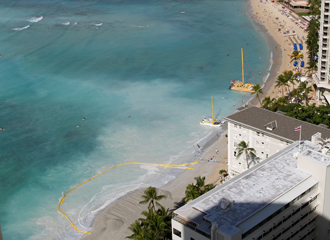Subscribe
Subscribe Now to receive Goldsea updates!
- Subscribe for updates on Goldsea: Asian American Supersite


Visitors to Waikiki this week found a section of the world’s most famous beach closed during morning hours as crews worked to replenish sand that has been eroded by waves over the years.
The sand is being supplied by a suction dredge barge anchored about 1,000 feet offshore in a surfing area that has been shallowed by deposits of sand sloughed off the beach. The barge holds a large dredge pump that sucks up nearshore sand and sends it through a pipeline to a dewatering area set up on the west end of Kuhio Beach — the east end of what most visitors call Waikiki Beach. The sand is then spread using earth-moving equipment along a 1,730-foot section of beach between the Hyatt Regency on the eastern end and the concrete groin in front of the Royal Hawaiian Hotel on the western end.
“I’m glad all this beautiful white sand isn’t being lost forever,” said a young woman who had come out from the Hyatt Regency for an early morning swim. “It’s not an inconvenience at all. You can walk to the water through the pedestrian access and the other parts of the beach are still open.”
The morning closures, which end each day at noon, began on March 12 and affects only a single section of about two hundred foot at a time. When the closures end on April 14, the dry sandy area of the beach will have been widened by 37 feet, its width in 1985. The wave action has been eroding about one to two feet of sand per year.
The $2.5 million project is undertaken by the Hawaii state Office of Conservation and Coastal Lands and is financed by $1.5 million in state funds, $500,000 from Kyo-wa Hawaii, owner of several Waikiki hotels, and donations from private conservations organizations.
The project, which will move about 24,000 cubic yards of sand, has the backing of environmental groups like Save Our Surf because it takes sand from areas that have become shallow by eroding sand, changing the surf in some places. The organization had opposed earlier efforts to use sand imported from other locations. In the 1920s and 30s sand was imported from Manhattan Beach, California using barges. In 2006-07 a state replenishment project had recovered 10,000 cubic yards of sand from the sea and pumped it onto the shore within the Kuhio Beach crib walls.
The state expects to repeat similar replenishment projects on a regular basis, with the next one coming possibly in a decade.

A 1,730-foot long section of Waikiki Beach is being widened with sand dredged from an area about 1,000 feet from shore during the first four months of 2012.